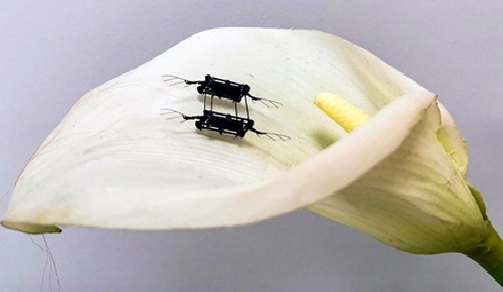Enhanced Performance of Microbots Enables Them to Fly Like Insects
After developing agile and resilient insect-sized drones that manoeuvered like real insects, researchers at MIT heralded a new advancement in micro-drones for use in rescue operations, industrial equipment monitoring or other real-world applications – a feat worth loud applause.
But there was a slight problem: the soft actuator powering the aerial robots required much higher voltages than similarly-sized rigid actuators. On top of that, these lightweight drones didn’t seem to adequately carry the necessary electronics. [4]

Figure 1. Enhanced Performance of Microbots Enables Them to Fly Like Insects
Figure 1 shows the result is an artificial muscle that forms the compact body of a robust microrobot that can carry nearly three times its weight (despite weighing less than one-quarter of a penny). Most notably, it can operate with 75% lower voltage than other versions while carrying 80% more payload.
They also demonstrated a 20-second hovering flight, which Chen says is the longest recorded by a sub-gram robot with the actuator still working smoothly after 2 million cycles – far outpacing the lifespan of other models. [3]
Interesting features of the microbot
The robot is created using material that contracts easily with the application of electric current. In the year 2019, a research team explained in a paper that this specific design can be used to construct an insect robot that can slither across a distance with a speed of about 1.5 miles/hour. This was also determined as a speed similar to that of cockroaches and also the fastest as an insect robot.
With the help of electrostatic footpads, an application of electric current can increase the force and make the robot glide through a surface in no time. It also makes the surface of the footpad sticky enough to stick to the ground while the rest of the robot can be rotated. Hence, these footpads allow the operators to fully control the movements of the robot which have a more advanced acceleration as compared to live insects. [1]
Challenges of Going Small
Broadly speaking, the greatest difference between microrobots and conventional robotic systems is their extremely small size, which imposes some severe constraints. The most significant is that microrobots are too small to easily incorporate any on-board power source, sensors, or computer circuitry. Features such as motors, electronic sensors, and self-contained intelligence—all commonly used in large robots—are generally infeasible for microrobots. Creative new methods and designs need to be developed to account for this critical limitation, and contemporary knowledge of macroscale robots cannot be directly transferred to the microscale. [2]
References:
- https://robofluence.com/tiny-robot-mimics-cheetah/
- https://www.americanscientist.org/article/tumbling-microrobots-for-future-medicine
- https://www.zmescience.com/science/the-swarm-is-near-get-ready-for-the-flying-microbots/
- https://www.electronicsforu.com/news/whats-new/enhanced-performance-microbots-fly-like-insects
Cite this article:
Thanusri swetha J (2022), Enhanced Performance of Microbots Enables Them to Fly Like Insects, pp. 81

